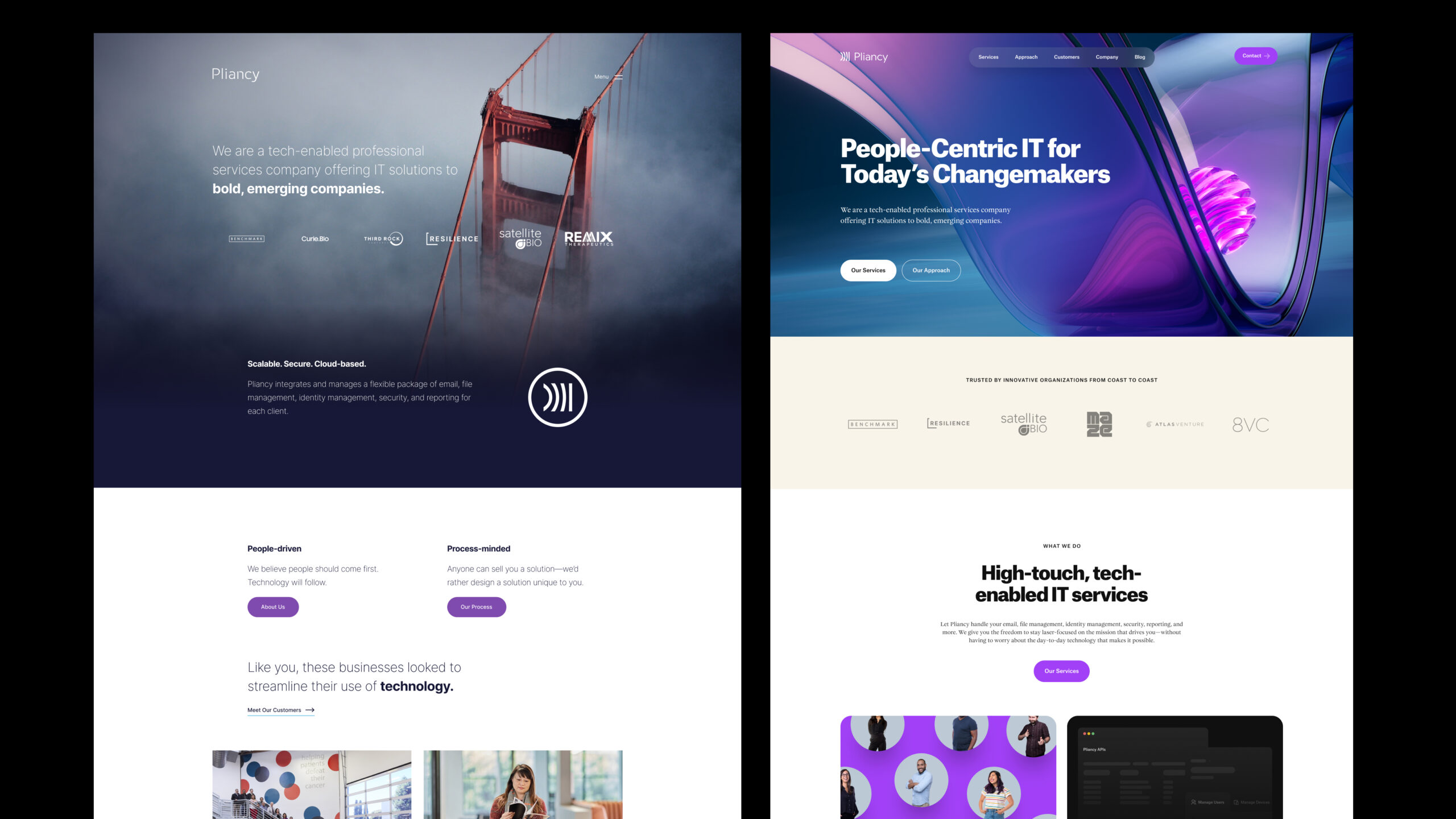Pliancy
Company
If you’re looking for a way to share files securely, you don’t actually need a data room. So why does anyone use one? Discover why data rooms are valuable for what they say about your company—rather than what they do.

Pliancy
Company

Many data room vendors want you to believe that a data room is the only thing standing between you and greatness. “Your catalyst for success.” “Achieve critical business outcomes.” “Where deals get done.” “Unlock productivity.”
There isn’t anything inherently wrong with data rooms, but they aren’t a dealbreaker. Having a beautiful data room won’t guarantee you a term sheet. Not using a data room platform won’t prevent you from getting funded.
At the end of the day, we believe that the value of a data room solution comes from what it signifies, rather than the function it actually provides.
Let’s rewind. A data room is a private digital space where you can securely share confidential files with external parties. Data rooms are primarily used by companies during the fundraising process, during merger or acquisition discussions, or when seeking capital from LPs.
In these situations, third parties need to review sensitive data as part of their due diligence. Data room solutions were invented to help avoid confidential data falling into the wrong hands or getting misused.
The key feature of a data room is that it gives you control of your information and who accesses it. You know who’s logging in, what they view, and when. You can enable multi-factor authentication, add watermarks, restrict the ability to download, edit, or screenshot files, and more.
Data rooms aren’t magic. No platform, no matter how sophisticated, can prevent an authorized user from pulling up a document and physically showing their screen to someone sitting next to them. Your data room won’t magically calculate how many sets of eyes looked at your file. That said, security features like these raise the barrier to unauthorized sharing. For the average use case, this is typically enough.
Data room platforms are expensive. There’s no sugar-coating it. They cost thousands of dollars, in the ballpark of ~$700 a month. Most companies should expect to pay four figures annually for their service, and many data room vendors will lock you into a 3-year contract (or longer).
A small startup might be paying $100 per user for licenses; a data room platform could cost as much as all their other software combined. So, if you’re a lean, bootstrapped company that’s just starting out, what are your options?
Good news: data rooms aren’t the only way to share your data safely. If you’re looking to replicate the features of a data room, you can get 90% of the way there using your existing file storage solution.
At Pliancy, we believe a DIY approach works best with Egnyte—even though they also have an official data room product—but you can also make it happen in other major storage providers that you may already be using, like Dropbox, Box, and SharePoint. (Approximating a data room in Google Drive is possible, but slightly more difficult due to Drive’s architecture.)
Going the DIY route essentially boils down to creating a folder that will act as your data room and adding the necessary files. It’s safest to build a DIY data room with the help of an IT professional. But if you are going it alone, keep these points in mind:
Pay close attention to what invited users are able to do. In almost all data room use cases, invited users should be able to view files only. (No adding, editing, deleting, or downloading.)
Depending on the provider, some file storage solutions allow you to see whether others are viewing a file. Google’s collaboration settings, for example, will show you which users (if logged into a Google account) and how many users are active in a document at any given time. For this reason, we suggest creating separate “data room” folders for each investment team you’re in discussions with.
Check whether your storage solution has expiring permission settings. If that option is available, establishing an expiration date is an important failsafe. Depending on the speed of your fundraising conversations, anywhere from one to six months can be appropriate.
If your solution does not provide this option, you’re responsible for manually revoking access for users who should no longer have it. To make sure an investor you spoke with once isn’t able to lurk years down the line, we suggest scheduling a regular audit of user permissions or revoking all access to your data room once your fundraising round has closed.
For more details on homebrewing a data room, read Packit’s Field Guide to Data Rooms, a resource from our new self-service IT offering for early-stage startups.
If BYO-data room gets you 90% of the way there, let’s outline the remaining 10%. Here’s what you’ll be missing if you decide to DIY your data room instead of paying for a platform:
With a data room solution, you can require that visitors agree to the terms of an NDA before they’re allowed to access your files.
Many data room platforms include the ability to add watermarks (including the user info and access date/time) to documents when previewing a file or, if allowed, when downloading it. Not only does the watermark act as an extra deterrent to distribution, but it also makes it easier to determine the source of unauthorized sharing if a document finds its way into the wrong hands.
You can brand your data room portal with your logo and brand colors. While aesthetics have no impact on the security of your data, this finishing touch makes accessing your data room feel like a cohesive, high-value experience.
Looking at the numbers, it seems like a no-brainer: $700+ per month on a long-term contract versus no extra cost and some elbow grease. Why, then, does anyone pay for a data room?
For companies with sufficient resources, the convenience of a data room can be worth the cost. The primary pitfall of a DIY solution is its integration with your existing file storage environment. Because your “data room” is just another folder in a system you use daily, you increase the chances of someone accidentally adding files you don’t want to share.
Using a true data room solution means a separate platform with a separate login—not someplace you’re likely to find yourself without meaning to.
Even more than convenience, using a data room boils down to looking professional. If you’re a sole founder raising a pre-seed “friends and family” round, sharing a PDF by email could be fine. Past that stage, many investors and LPs will expect you to use a data room, and there is value in meeting that expectation.
A data room is something we regularly recommend to clients solely for the purpose of looking more mature and looking better in the eyes of an investor—even though it might not deliver meaningful value beyond that. Maybe it upgrades your security posture by 1%, sure; but it absolutely looks good on a due diligence questionnaire.
Ultimately, there is no hard-and-fast milestone when it comes to data rooms. There is no rubicon you will cross and then suddenly find that having one becomes non-negotiable.
How you choose to share your data is a personal decision based on the investors you’re speaking with, the maturity of your company, your available resources, and how you want to use them. Your needs will change over time, as will the expectations of your investors. Do your best to find the balance, and know that data rooms are just one piece of a much larger puzzle.


Get updates from Pliancy delivered straight to your inbox

We’ve got the lowdown on due diligence questionnaires. With this explainer in your back pocket, you’ll be able to tackle DDQs with confidence.

Noah Tagliaferri
VP of Growth

Onboarding can be a nightmare for employees. It doesn’t have to be—if you remember who you’re building for.

Tiffany Kress
Head of People

Brands are always evolving, and Pliancy is no stranger to reinvention. We look back on our brand update, six months later.

Kyle Barber
Associate Creative Director
Not all file storage platforms are created equal. Find out why SharePoint is a risky choice for life sciences companies.

Pliancy
Company

When you partner with Pliancy, you’re not getting off-the-shelf solutions. Our hardware, software, and IT operations recommendations are the result of intensive research, in-house development, and years of experience providing IT to bold companies.
That also means we’ve developed some strong opinions along the way. It’s not our style to report artificially objective pros and cons, ending with a noncommittal recommendation to “choose what works best for you” (thus abdicating any responsibility). If you ask for our opinion, you’ll get one.
Pliancy has supported emerging life sciences companies since 2008, giving us a front-row seat to the industry’s challenges, milestones, and common trajectories. We’ve seen it all: hypergrowth, steady maturation, acquisitions, mergers, IPOs, and more.
Amidst the research, fundraising, and scaling, most people don’t think about file storage. You know it’s there, you assume it’s going to work, and most of the time, it does.
But what about when it doesn’t?
Today, we’re taking a strong stance on file storage for life sciences companies: Unless you want to risk your storage environment collapsing without warning someday, choose anything but SharePoint.
Across all industries, many companies use SharePoint as their primary storage solution—even though it was never designed to be a file repository. In reality, SharePoint is a Microsoft tool originally intended for building employee intranets. Microsoft’s own product page describes SharePoint as “Your high-scale content platform for Microsoft 365.”
The reason why people use SharePoint for file storage is a predictable one: cost. For companies already paying for Office 365 licenses, SharePoint feels like an easy, “free” solution because it’s already included.
We’re not suggesting that SharePoint must be scrubbed from the earth entirely. In our experience, there are scenarios in which SharePoint may serve as an adequate file storage solution:
If you’re mostly emailing text files and/or most of your work takes place offline, SharePoint may work for you. Small-to-medium service businesses tend to fall in this category (law firms, lawn care companies, restaurants, etc.). Companies that work with large files, like videos or images, or large datasets are not a fit.
Meeting regulatory or compliance requirements typically involves strong security baselines. Due to the design of SharePoint’s architecture, it can be difficult to meet security specifications out of the box. Meeting compliance requirements with SharePoint often involves paying for advanced security licensing for every user—meaning your “free” SharePoint isn’t so free anymore.
As designed, SharePoint’s architecture limits its ability to handle complex permissions or folder structures. If the nature of your work requires nested permissions—that is, if sub-directories within a shared folder require different access permissions than the overarching parent folder—you will have to invest extra time and effort to create and manage those permissions if using SharePoint. It’s not impossible, but it’s much more difficult than when using other, more modern platforms.
Critically, biotechs don’t fall into any of the above categories (they usually have large datasets at their core and are frequently subject to HIPAA and other compliance requirements). Sure, some people have used and will use SharePoint without ever experiencing issues, but they may not be aware of the possible perils.
Using SharePoint as a life sciences company is a high-risk strategy with a low-value reward. It may seem “free” (i.e., included with your Office 365 subscription), but compared to true file storage solutions, SharePoint has slower upload speeds, access control issues, and guest and collaborator settings that can be mysteriously finicky.
Even these shortcomings pale in comparison to SharePoint’s biggest pitfalls: poor reporting and a known breaking point.
Good reporting is like insurance: you hope you don’t need it.
In your day-to-day operations, you probably won’t think about detailed reporting very often. But every once in (hopefully) a long while, reporting will become an essential puzzle piece in protecting the security of your business.
Once an employee leaves a company, they’re considered a potential threat—at least in a cybersecurity specialist’s eyes. (We promise it’s an abundance of caution and nothing personal.)
Say you have an employee who leaves for a direct competitor. Maybe there’s an indication of suspicious activity, or maybe there’s not, but you get the heebie jeebies anyway. You want to find out what files the employee opened in their final weeks and what they downloaded. How hard could that be, right? Spoiler: It’s more difficult than you’d hope.
Imagine a bad actor successfully phishes an employee’s Microsoft account and gains access to your environment. Whether you find out hours or months later, it’s critical to review what they were able to access, download, upload, or otherwise interact with via that employee’s account. Time is of the essence in any security incident—so you don’t want to be stuck waiting around for reports to be delivered to you.
Unfortunately, getting answers in either scenario is not straightforward. We’d need to design and run multiple reports in SharePoint to get this information. Sharepoint requires specialized queries & sometimes specific licensing to make sure your ducks are in a row. Even then, sometimes the reports from Microsoft’s Compliance Center can take eons to get through a particularly large Sharepoint environment.
If Microsoft’s servers are particularly slow one day (note the fact that this is even a consideration!), we may even run a report and not get it until the next day—only to find that the parameters weren’t exactly correct, by SharePoint’s fussy standards, meaning we have to run it again.
Other storage platforms could pull reports like these in seconds. With any file solution other than SharePoint, this request could take as little as five minutes—including the time it would take us to read your request, input the query parameters, and send the report back to you.
By far, the riskiest thing about SharePoint is that it has a perilous, and ill-defined, breaking point. Microsoft’s official threshold is “300,000 files,” but their documentation fails to specify what kind or size of files they mean—an important detail. When “file” can mean 8 KB of plain text or 1.6 GB of video, the spectrum for danger is wide indeed.
For SharePoint’s product designers, 300,000 files probably felt like infinity for an internal content platform. But when used for file storage, 300,000 comes much sooner than you’d think.
SharePoint syncs data back and forth constantly to make files available on different machines and for different users. There is a certain point—again, an indeterminate one—at which SharePoint decides there’s too much data for it to handle and stops syncing.
Yes, you read that right. SharePoint won’t lock you out, give you a warning, or try to upsell you on more storage capacity. It’ll just stop working.
Like a tree falling in a far-off forest, you might not know anything has happened immediately. Then the user complaints will start to roll in:
– “All of my files disappeared! Did they get deleted? How do I recover them?”
– “I can’t find my lab data. It was uploading fine earlier today, but it’s all missing now. Do I have to run everything again from scratch?!”
– “I tried moving a folder, but it keeps reappearing in the old location. I’ve deleted it six times and it keeps coming back. How do I stop it?”
– “My files aren’t showing up on my computer, but SharePoint web shows they’re there. Is my laptop broken? Do I need a new one?”
Thankfully, experiencing a SharePoint break doesn’t mean your data is lost. However, it does mean your environment is essentially bricked. Sharepoint is the only platform that becomes completely unusable when you reach its limit.
To recover, you’ll need to immediately migrate to another platform or begin an organization-wide effort to restructure your SharePoint environment. Migrating may seem like an extreme solution, but in our experience, restructuring a SharePoint environment is typically the taller order.
A file share restructuring is a company-wide endeavor—not simply an IT project. Most companies simply do not have the bandwidth to have every employee (or even just department heads) participate in a restructuring plan. At the same time, your company would be at a standstill, because you can’t move files and folders around during the process. It’s easier to lift and shift everything in a big group to any other platform and re-permission it from the ground up.
Any migration is a big undertaking; it certainly doesn’t get easier when you’re making the move under duress. But a potential emergency migration is just one of SharePoint’s many hidden costs. Companies using SharePoint also need to consider the cost of:
– External tools (like Sharegate) for improved reporting, sharing, and permissions management
– Additional licensing for expanded security logging
– Third-party SharePoint developers to architect SharePoint for scalability
Most importantly, lab data is a critical component of a biotech’s IP. Losing access to it, even for one day, means losing thousands of dollars (if not more) in lost productivity across your organization.
With all of SharePoint’s dangers and costs, “free” isn’t quite the deal it seemed at first glance. The risks are sky-high, and the payoff—at least in our opinion—is nowhere near worth it.
We tend to recommend Egnyte for our life sciences clients (and they noticed: read our case study with Egnyte), with Box as a close second. Google Drive and Dropbox are distant options, but at the end of the day, any true file storage platform is an improvement on SharePoint. Other alternatives will have greater throughput (translating to faster speeds), robust reporting, the ability to handle complex user permissions, and—critically—no breaking point.
What if replacing SharePoint isn’t on the table? We get it: Some leadership teams might be hesitant to move away from SharePoint, especially if they’ve used it successfully at one or more previous companies.
If the looming threat of collapse isn’t enough to convince them, we have helped clients implement an alternative that divides file storage into two segments: G&A (general and administrative) data remains in SharePoint. A separate Egnyte environment, with dedicated data pipelines, handles all lab data.
While this compromise adds an extra layer of complexity for users who need access to both segments, it’s a straightforward way to mitigate the danger of SharePoint’s hazy file limit if eliminating SharePoint is not feasible.
Perhaps you’re a biotech that currently uses SharePoint, and migrating isn’t possible in the immediate future. At Pliancy, we’re not in the habit of leaving you high and dry. Here are a few tips to help you optimize your environment now and prepare for an eventual migration.
As mentioned above, SharePoint constantly syncs data for every file and folder each user has access to. If all of your company’s files are stored in one SharePoint site, this can create a high degree of stress on SharePoint’s architecture.
To improve performance, you can create dedicated document libraries or dedicated SharePoint sites for large files (like videos) or large datasets (high volumes of small files). By limiting access to only those who need them, you can prevent SharePoint from syncing these large files or folders unnecessarily, conserving system resources.
A data governance policy establishes overarching rules and procedures for managing assets, controlling access, ensuring data accuracy, and keeping your assets secure. It also defines roles and responsibilities related to data ownership and maintenance.
Without a unified data governance approach, the maintenance of any file system becomes infinitely more difficult. Because OneDrive (essentially a personal storage drive) is integrated with SharePoint, users will often default to using their individual OneDrive storage for uploading and sharing files or folders. However, most users don’t realize that this can be dangerous in the long term. When a user leaves an organization and the license has been removed from their account, all of their OneDrive files are deleted after a fixed period of time, usually in 30 or 90 days depending on the environment’s settings.
Instituting a data governance policy can prevent your file system from becoming a tangled mess because each stage of the data lifecycle has SOPs and guidelines, as well as parties accountable for making sure the work gets done and protocols are followed.
On any storage platform, using logical folder structures and descriptive file names can improve both user experience and search performance. However, this change is rooted in human habit. There’s a common misconception that file structure is solely an IT issue. It’s not; a successful file management framework requires buy-in from the entire organization.
An IT team can provide all the guidelines they like. They could even designate themselves as the only ones with permission to create and change folders. But at the end of the day, users are the ones saving, naming, and searching for files. (For tips, check out this file organization demo from Packit, powered by Pliancy.)
There’s a time and a place for SharePoint. As we’ve mentioned, it can work for companies within certain parameters, and we support a number of clients who choose to use it.
We would love Microsoft to up their game and develop a truly competitive cloud-based file storage solution from scratch. Perhaps they just don’t have any incentive to do so; plenty of people use SharePoint despite its shortcomings. Maybe there’s a secret product in Microsoft’s pipeline, and we’re just months away from being delighted by the next evolution in storage solutions.
Until that day, our view remains that life sciences companies should avoid SharePoint in favor of a more reliable, more secure solution that is properly equipped to handle your lab data, your operations, and your compliance requirements.
SharePoint may be able to get the job done—but are you willing to roll the dice?


Get updates from Pliancy delivered straight to your inbox

We’ve got the lowdown on due diligence questionnaires. With this explainer in your back pocket, you’ll be able to tackle DDQs with confidence.

Noah Tagliaferri
VP of Growth

Onboarding can be a nightmare for employees. It doesn’t have to be—if you remember who you’re building for.

Tiffany Kress
Head of People

Brands are always evolving, and Pliancy is no stranger to reinvention. We look back on our brand update, six months later.

Kyle Barber
Associate Creative Director
We’ve got the lowdown on due diligence questionnaires. With this explainer in your back pocket, you’ll be able to tackle DDQs with confidence.

Noah Tagliaferri
VP of Growth

Getting ready to complete a DDQ? Don’t sweat it. Due diligence questionnaires may seem intimidating, but all you need to succeed is an intentional approach and a little preparation.
I’ve processed hundreds of DDQs for dozens of clients in my IT career. This explainer distills everything I’ve seen and learned into a handy guide you can refer to before and during your first DDQ request.
What is a DDQ?
A DDQ, or due diligence questionnaire, is one component of the operational due diligence (ODD) process, which helps investors evaluate a business’s risk by assessing its operational readiness, intellectual property, and more.
Whether you’re a biotech company raising your Series A or a VC firm seeking capital from limited partners, DDQs are a critical part of demonstrating that your business is a wise investment.
Who Receives DDQ Requests?
Ten years ago, IT and cybersecurity didn’t play a huge role in DDQs for early-stage companies. A company might not be scrutinized on those aspects until reaching an inflection point like raising a Series A or courting funding from a retail bank, large endowment, or similar.
But over the last 5 years, and even in the last 3 years, the scope of DDQs has changed drastically. We’re seeing more and more of these questions, even for emerging VC firms raising their first funds and for nascent life sciences companies with only 5 employees.
Even outside of the vacuum of DDQs, society is moving toward a world where everyone is concerned about cybersecurity. No matter how small you are, investors and regulators care about your cybersecurity readiness. We’re headed in a direction of increasing scrutiny, making your attention to issues like data security and compliance more critical than ever.
When investors send you a DDQ, they’re looking for confirmation that investing in you is a sound idea. Are you running a tight ship? Will their reputation be at risk if they partner with you? How likely is it that you’ll get breached? Are you following relevant compliance guidelines?
A DDQ can mean the difference between receiving a check from an investor and getting a polite—but firm—“we’ll pass.” However, this doesn’t mean that investors use DDQs to find reasons to say no.
If you get to the DDQ stage, it’s because they like you and your company; they want things to pan out. They aren’t hunting for the chance to disqualify you on something like a cyber policy. They just have to do their homework first.
Let’s start with the bad news: Every DDQ you receive will be different, both in terms of format and content. It might arrive as an email, an online form, a PDF, a Word document, or even a spreadsheet or matrix.
Unfortunately, you also can’t expect any two DDQs to phrase every question the same way. In fact, some DDQs might be only 5% related to IT. Some investors may send you a separate questionnaire focusing solely on cybersecurity.
Thankfully, DDQs will—for the most part—ask very similar questions about your operations, compliance, governance, cybersecurity, and your investment thesis (for investment firms) or your intellectual property (for all other businesses).
Though you won’t be able to copy and paste every answer, this silver lining means that DDQs will get easier over time. There may be a few new details, but completing your second, third, tenth, and fiftieth DDQ will primarily involve rephrasing your company’s responses to match each questionnaire and its unique phrasing.
Submitting your DDQ answers might feel like shouting into the void, but remember that it’s a conversation. The investor might have follow-up questions, allowing you to provide more context as needed, whether in an email or live on a call. If there’s a gap between where you are and where the investor wants you to be, in almost all cases, you’ll have an opportunity to meet in the middle.
Working with biotechs, VC firms, and other clients, the biggest misconception I’ve encountered is that every question’s answer must be “yes.”
That’s simply never going to be the case.
Many companies will have one DDQ that they send to every firm, regardless of size, industry, or stage of maturity. There will inevitably be a question that’s phrased in a way that doesn’t apply to you; there will be something you don’t do, but you have a mitigating risk factor. There will be an outdated question that should have been removed years ago, or a question intended for a company much bigger than yours.
Answering “no” to a DDQ question isn’t the end of the world—as long as you have a good reason for your response.
When completing a DDQ, it’s less about the right versus the wrong answer and more about giving a thoughtful response. Whether you’re saying “yes,” “no,” or “maybe,” investors want to see responses that show you’ve given careful consideration to each topic.
Imagine you’re an emerging VC fund with 5 employees, all working out of your homes from personal computers and personal phones. After connecting with a retail bank about funding, they send you a DDQ.
It asks, among other things, if you perform penetration testing on your physical office. (A penetration test, or “pen test,” refers to an authorized, simulated cyberattack designed to find vulnerabilities in a computer system and ensure security controls are working as designed.)
In a scenario like this, there’s no office, no on-site servers, not even a shared printer whose cache could be compromised. If all you’re using is Google Workspace, does this mean the retail bank expects you to pen test Google? At the end of the day, the question just doesn’t apply.
In the hypothetical above, you might be inclined to just answer “no” and move on. That would technically answer the question, right? Sure. But a better answer—one that shows you’re paying attention—might look something like this:
“Because the firm is cloud-based and has no physical locations or physical assets that stand behind any firewall or network, penetration tests of a physical office are not necessary for our environment. However, we do use single sign-on and work with an external provider to monitor our systems and investigate suspicious activity immediately.”
This response contains two critical elements. It:
– Explains why the answer is a “no”
– Offers supplementary information that addresses the question’s core concern
Giving an in-depth response shows you don’t just understand what the question is asking; it shows you understand why they’re asking it.
Even before you receive your first DDQ, you should prepare a summary of your cyber posture to use as a starting point. This should include:
– A list of all platforms and tools your business is using
– Whether or not they have MFA (multi-factor authentication) enabled
– How your devices and systems stay updated
– A description of your protections against phishing, malware, viruses, and other threats
– Steps you’ve taken to comply with recent SEC rulemaking
– Your planned response in case of a cyber incident
– How you secure your company’s equipment and premises (if applicable)
The way you complete your DDQ speaks volumes about you and your company. Instead of seeing it as an obligation, think of a DDQ as an opportunity.
It would be easy to treat it like a boring, check-the-box exercise—and many do. But there is the potential for so much more. Make sure your responses embody your attitude toward your work. Demonstrate your capacity for critical reasoning. Showcase your foresight, your attention to detail, and your preparedness for what’s ahead.
More than anything else, seize the opportunity to prove why you, and only you, are the right choice for this investment.
Still have questions about DDQs? Book time with our Growth team to find out how Pliancy can support your company through this process and more.

Clients can visit Pliancy’s Trust Center to access our plans and policies, including a free security report that should provide all the information your audit team needs to complete standard DDQs and related requests. Additional support is available for complex forms and requests. Please contact your primary consultant for more information.
Get updates from Pliancy delivered straight to your inbox

We’ve got the lowdown on due diligence questionnaires. With this explainer in your back pocket, you’ll be able to tackle DDQs with confidence.

Noah Tagliaferri
VP of Growth

Onboarding can be a nightmare for employees. It doesn’t have to be—if you remember who you’re building for.

Tiffany Kress
Head of People

Brands are always evolving, and Pliancy is no stranger to reinvention. We look back on our brand update, six months later.

Kyle Barber
Associate Creative Director
Completing our SOC 2 examination means you can trust Pliancy’s rigorous security standards to keep your information and data safe.

Brian Zabeti
Security & Compliance Manager

On behalf of Pliancy, I’m excited to announce that we completed our SOC 2 examination earlier this spring. This accomplishment underscores our dedication to meeting and exceeding rigorous security standards that keep your information and data safe. The report is now available to clients through our Trust Center.
SOC stands for “Service and Organization Control,” an audit service regulated by the American Institute of Certified Public Accountants (AICPA) and the Chartered Institute of Management Accountants (CIMA).
A SOC 2 examination evaluates and reports on the suitability of the design and operating effectiveness of controls in 5 Trust Service Categories, established by the Assurance Services Executive Committee (ASEC):
– Security
– Availability
– Processing Integrity
– Confidentiality
– Privacy
As a partner, client, or a prospective client of Pliancy, our SOC 2 report means you don’t have to just take our word for it; Pliancy’s systems and processes have been thoroughly audited by an objective, certified third-party CPA firm, so you can have even greater confidence in the security of your information.
Pliancy’s control environment is built to follow SOC 2 and ISO 27001:2022 frameworks, which simplifies the process of completing due diligence questionnaires (DDQs) and other risk assessments. Moving quickly through vendor evaluation means we can start your onboarding process and ongoing support as soon as possible—so you can focus on your core business, not IT.
After completing our SOC 2 audit for the first time, our policies won’t be left to gather dust. Compliance must be renewed annually, so our systems will be regularly reviewed and updated in response to developing technologies, security risks, and other trends. Our compliance helps you reduce your risk, no matter what the future brings.
Leading Pliancy’s SOC 2 initiative, I had a front-row seat to the hard work and dedication it took to make compliance a reality. It required collaboration and coordination from the entire organization, at each level of seniority and across every function.
Our VPs took ownership and paved the way forward. Managers made sure SOC 2 was given bandwidth alongside other projects. Individual contributors made implementation and evidence collection possible. I had the pleasure of partnering not only with technical colleagues in engineering and professional services, but with business operations, people operations, finance, and other supportive roles to reach control readiness.
This all-hands-on-deck mentality is nothing new for Pliancy. When you ask your consultant to solve a problem, you’re not getting help from just one person. You’re leveraging the knowledge and experience of dozens of technical staff, plus the critical reasoning and outside-the-box thinking of our entire organization. We inspire one another to devise innovative approaches, creative solutions, and unexpected fixes every day.
In the same way, our cross-functional collaboration for SOC 2 compliance means controls are embedded throughout Pliancy. It’s not just the responsibility of the security and compliance team. At Pliancy, in ways big and small, we’re all working proactively to protect you and your information.
Clients can directly request access to Pliancy’s SOC 2 report through our Trust Center. For more information and questions regarding SOC 2 and our control environment, please contact your primary Pliancy consultant.

Get updates from Pliancy delivered straight to your inbox

We’ve got the lowdown on due diligence questionnaires. With this explainer in your back pocket, you’ll be able to tackle DDQs with confidence.

Noah Tagliaferri
VP of Growth

Onboarding can be a nightmare for employees. It doesn’t have to be—if you remember who you’re building for.

Tiffany Kress
Head of People

Brands are always evolving, and Pliancy is no stranger to reinvention. We look back on our brand update, six months later.

Kyle Barber
Associate Creative Director
Brands are always evolving—and Pliancy is no stranger to reinvention. We look back on our brand update, six months later.

Kyle Barber
Associate Creative Director

If I asked you to dress exclusively in your wardrobe from 10 years ago, how would you feel? Would the clothes fit you well? Would they match your current style, size, habits, or environment? Would they make you feel your best?
Like the clothes we wear, brands are a reflection of identity. They are always evolving—and Pliancy is no stranger to reinvention.
We got our start in 2008 as TSG, an accurate but plain initialism that stood for “Technology Strategy Group.” In 2017, we underwent a full rebrand to Pliancy, with an aesthetic and verbal identity that more clearly reflected our relationship-focused, tech-forward approach to IT. In June 2023, we brought our third iteration to life with a redesigned website, expanded palette, updated logo, and more.
From an outside perspective, a new website and a brand refresh can seem like a single event: one day, and everything changes. In reality, it’s a months-long process that both starts long before and extends far beyond launch day.
“Is rebranding really necessary?” you might ask. A brand is a point-in-time expression of a business: its philosophy, its history, its trajectory, and more. Some of those facets will stay the same; many of them will change over time.
Compared to 2017, Pliancy is a drastically different company. Our headcount has increased by leaps and bounds, our service offerings have expanded, and we now serve clients across the country. We were also operating in a rapidly changing IT landscape. Five or ten years ago, just having a cool brand presence was enough to set you apart, but we needed something more. It was time for our branding to reflect the size, scope, and capabilities of Pliancy as it exists today.
We didn’t wake up one morning and throw everything out the window, of course. Like any major project, we began with an internal audit. I interviewed key stakeholders to get their insights on how our brand impacted their roles and professional relationships—but I also met with anyone else who would volunteer, no matter where their position or tenure. If we claim to be a people-centric organization, then that has to be the bedrock of everything we do. An expression of our company’s identity can’t be driven solely by leadership alone. It belongs to all of us.
Conversations with colleagues from all corners of the company gave me a full-spectrum understanding of how people saw our brand, their favorite and least favorite elements, content wishlists, and other observations. Everyone had drastically different ideas of what our refreshed brand and website should encompass, shaped by their individual responsibilities and relationships.
I ended up with multiple massive spreadsheets of comments describing what people wanted the brand to be or do. We couldn’t implement everything (and not just because some opinions were completely at odds with others), but that feedback shaped the first iteration of the website’s new architecture. It directed our conversations about what we needed the updated branding to accomplish and helped us keep all perspectives in mind.
To design our next evolution, we partnered with Overline, who has walked with us through many phases of Pliancy from our early growth to now. (Read more about our collaboration.)
An early and obvious goal was to maintain continuity with our existing elements and language. We didn’t want to abandon everything that had gotten us to where we were. Not only would that alienate clients and colleagues, but it would also render our old assets completely useless.
Digital assets tend to persevere—for better or for worse. We wanted to make sure that if you saw an old Pliancy deck from four years ago, it would still be recognizable as the same brand.

We call our logo the Occam, a tribute to Occam’s razor, to represent our pursuit of the simplest, most elegant solutions. That concept is a core part of Pliancy’s DNA, therefore we knew the idea of the Occam wouldn’t change, nor would we depart from our signature purple.
To reflect our relentless pursuit of less—less complexity, less obfuscation—we eliminated the border around our mark for a cleaner aesthetic and a more powerful impact at small sizes. Like the next evolution of Pliancy, the new Occam is free and unbounded, embodying the dynamism of our future trajectory. We also enriched the purple color to make it more dynamic, a change we carried throughout our expanded, updated palette.

This was a step-up evolution, not a drastic change. We weren’t trying to change the direction of the company or distance ourselves from an earlier version of Pliancy. Our brand evolution simply needed to match the evolution of our business. In tandem, our website needed to move from ambiguity to clarity.
It has been years since we were a Palo Alto-based company with a single-digit headcount. But if you visited our website in May 2023 and were greeted with a photo of the Golden Gate Bridge—one that hadn’t changed since 2017—you might think we serve Bay Area clients only. At the same time, the language around our services was cryptic and obfuscated what clients could expect day-to-day.

Pliancy now has six offices in four states, serving clients from coast to coast. To unhook ourselves geographically, we introduced intricate 3D renderings from artist Bryan Barger, adding dimension, motion, and wonder to our assets without referencing specific regions.

These striking visuals encapsulate the transformative magic of Pliancy’s tech-enabled professional services. We highlight transparency with glass & light textures; automation and iteration with repeated movement; and knowledge with an internally lit core to represent the way that our knowledge powers everything we do. Paired with transparent explanations of our services and approach, the new site and related assets now possess a more straightforward expression of Pliancy’s offerings and ethos.
Any brand adjustment, whether it’s a full identity change or a refresh, has three phases: planning, design, and rollout. Our third phase began with our website launch, the biggest (and most public) part of the rebrand—but that was only the beginning.
Our initial audit outlined a list of about 20 assets that would need to be updated: email signatures, deck templates, social media, the usual. While we knew the list wouldn’t be exhaustive, we thought we’d be close. In practice, the real scope dwarfed our initial list.
Think about all the places your logo appears: throughout your intranet, in your HRIS platform, as part of your Slack theme, on your two-factor authentication screens, in your training modules, on company Zoom backgrounds… Six months later, we’re still finding places to update.
Why do small updates matter? If updating a brand is updating your wardrobe, these details are akin to your accessories. Belts, socks, hats, bags, pins, and patches—these are the difference between wearing an outfit and styling one. It may feel like an endless (and thankless) task, but every instance contributes to brand cohesiveness and brand strength.
The silver lining to making a million minor updates: it’s a team effort. We didn’t have to hunt down every instance for ourselves; in many cases, it came to us. In the course of their work, colleagues across the org found things we’d missed and made the effort to flag them, reflecting the signature Pliancy drive to make things better, in ways large and small.
Pliancy is unique in the way that everyone (or almost everyone) actually cares about or has interest in our brand. Everyone knows that we use it to put our best foot forward from the beginning. It’s a big part of our culture. We don’t send out messy pitches or ugly proposals. We don’t just plaster our logo on a 5¢ ballpoint pen and call it swag. When it comes to brand, we don’t phone it in.
Your company might also have an environment where brand resonates—or maybe not. If you’re finding it’s an uphill battle, here are a few strategies that work for Pliancy.
To maximize buy-in and familiarity, branding should be part of the conversation from the start. During their first two weeks, new Pliancy employees attend multiple onboarding meetings to teach them about the company. We dedicate an entire meeting to our brand history, its role, and why it’s important, sharing our thought process and intent.
Employees should be able to recognize their company’s branding immediately. To do that, they need to see it consistently. We brand as much employee communication as possible: all hands meetings, slide decks, internal event flyers, employee handbooks—just to name a few. It’s not a low-lift endeavor, but it’s an investment we make in order to equip team members to act as brand stewards. If they can identify our brand right away, it means they’re more likely to notice when something is off-brand.
For the group in charge of branding—whether that’s your Creative department, your Design squad, your Communications team, or your Marketing arm—no task should be too small. As the primary person responsible for visual branding updates, I’m not above any little thing. If I have to sit and swap logos in 50 different places, I consider that a good use of my time. I want to show my colleagues that branding work matters to me. And not only does it matter to me, but it matters so much to me that I want it to matter to them, too.
At Pliancy, branding is about more than just looking good (though we like when things look good, too). It’s a way for us to express who we are, how we work, and what we value.
We know this won’t be the last iteration of Pliancy. Change is the only constant, after all. So no matter how we change, we’ll be prepared to meet our future selves wherever we’ll be: with a new shape, a new size, a new color—whatever we need.

Get updates from Pliancy delivered straight to your inbox
When it comes to proving your IT mastery, there’s no silver bullet—but certifications still have a purpose.

Nicholas Thomas
Infrastructure Projects Manager

Like the choice of Google Workspace versus Microsoft365 or the debate of how a VLAN differs from a subnet, IT certifications are divisive. For some, they’re a hard-earned symbol of new knowledge. For others, they’re the bare minimum to be a hirable candidate. For still others, they’re merit badges, obtained just for show.
There’s no shortage of online discourse about certs: “Do IT certifications matter” returns 99 million Google search results. “Are IT certifications important”: 374 million results. “IT certifications benefits”: 353 million results. “IT certifications cons”: 868 million results.
My stance? IT certifications are not the be-all, end-all way for a person to prove their knowledge or advance their career. But just as one should use the right tool for the right job, IT certs have a valuable place in the industry as a launchpad for early professionals.
If you’re reading a blog post on an IT company’s website, you probably already know what a certification is (and you probably have a couple, too). For those who don’t, IT certifications are credentials awarded to individuals who have demonstrated their knowledge of a particular aspect of technology, typically by passing an exam.
Certifications from vendor-neutral organizations cover universal foundations and fundamentals that aren’t restricted by product or platform. For those exams, it doesn’t matter how Amazon or Google or Microsoft does something; individuals need to know the underlying principles behind the technology.
These vendor-neutral certifications give you an opportunity to see what companies across the field do, their strengths, and their weaknesses. This helps you keep a pulse on industry leaders and challengers, which is key information for an IT consultant looking to keep their clients on the bleeding edge.
Vendor-specific certifications validate knowledge within particular products, often diving deeper into step-by-step processes versus methodology or approach. Vendor-specific certifications aren’t just limited to big names like Cisco and Microsoft.
More and more companies have begun offering specific certifications for their products, which has flooded the certification “market,” to some extent. For some organizations, vendor-specific certifications are a requirement to be able to sell or work on a product/service and inspire folks to continue their learning journey. Of course, this is a double-edged sword and can lead to gamification or other divisive means. (We’ll come back to that.)
My learning journey in this field included a course of study in computer science, but my industry experience would be refined with certifications. I started small with CompTIA’s A+ exam pathway. I read the book, took a practice test, and saw that this applied field of support and critical thinking was definitely the right choice for me to pursue.
I’m also a goal-motivated person, so the looming exams kept me attentive and engaged. They expanded my knowledge and helped me see how vast the world of IT, with its many specializations, could be.
For me, these certifications functioned the way they were intended: they attested to a baseline level of knowledge in a particular topic or product. They got me noticed, and they got me in the door. But once I was there, I saw a darker side of things.
I interned and eventually began working full-time at a traditional MSP (managed services provider) where getting a raise meant you had to obtain a new certification. Many factors can impact compensation and career advancement, and earning an industry certification is a valid consideration.
But at this organization, it was the only consideration—above job performance, billables, and operational efficiency. (Thankfully Pliancy doesn’t operate this way, but I would come to find that this mindset isn’t uncommon among MSPs.)
Employees adjusted their behavior accordingly. I’m sure some genuinely sought and absorbed new information, but many gamified the certification process, ignoring calls and tickets in favor of cramming exam materials. The knowledge itself didn’t matter; the exams were merely means to an end.
One particular memory stands out to me: I received a call from an overnight technician with several Microsoft certifications, Exchange being one of them. He told me that the Spam Filter was spooling emails and that the Exchange database was dismounted.
Naturally, to avoid suggesting something he’d already tried, I asked what he had done so far to diagnose or resolve the problem. He said his first step had been to call me.
It was immediately apparent that he didn’t have a great sense of how to troubleshoot Exchange, regardless of what the certifications implied.
The takeaway: certifications are not necessarily the best (and certainly not the only) way to sift out who’s experienced and who’s not.
There’s no magic way to weed out professional test-takers from those with practical skills. Every test is different, and they change over time, but there is one that I can speak to from personal experience.
Earlier this year, I was invited by CompTIA (Computing Technology Industry Association, the largest vendor-neutral credentialing program for technology workers) to contribute to the next iteration of the Cloud+ certification exam. Over three days at their global headquarters outside of Chicago, Illinois, our motley group of SMEs—from Google, Amazon, Microsoft, Backblaze, and more—was trained in CompTIA’s exam writing methodology and learned the test’s objectives before getting to work creating questions.
Our goal was to create material that was applicable across any cloud environment and rooted in practical experience, not rote memorization.
Writing and reviewing material was a collaborative process. Like a writer’s workshop, we would unpack why a question was a good test of knowledge or why another didn’t meet the test guidelines. It was our responsibility to put current, applicable questions forth. (We’ve all taken outdated tests that have made us shake our heads and think, ‘What year is this from?’) The experience hammered home that technology is ever-evolving and ever-changing—so technology exams must, too.
Certifications are changing, but not always for the better. As certifications have proliferated, they’ve become increasingly commoditized. What’s to differentiate one from another—except that maybe you got one for a steal on Black Friday? (Yes, there are Black Friday sales for certification courses.)
There are also free certifications, but you know what they say: if something is free, you’re the product. Displaying a badge from a lesser-known platform on your resume, on your LinkedIn profile, or in your email signature is free marketing. In cases like these, it’s in a company’s best interest to award certificates to as many people as possible.
All of this begs the question: What is the true value of an industry certification?
Examining certifications in a vacuum—trying to paint them as inherently good, bad, useful, or useless for everyone—misses the point. Instead, we should consider what people are trying to achieve and whether industry certifications can meet that need.
As a new professional or a career changer, hands-on experience isn’t always possible. Pursuing certifications can demonstrate your performance against an established standard. Instead of just saying you’ve “always been good with technology,” passing scores on foundational exams can substantiate those claims—to an extent.
Studying for an exam is a convenient way to discover whether you have an affinity for a specific topic. If you’re part of a small team or at a siloed company, studying for exams and/or creating an experimental lab environment of your own might be the only way for you to gain exposure to the more specialized or advanced facets of IT.
At a company where certifications are the only way forward, you may have no choice but to play the game, get the badges, and check the boxes. But speaking broadly, certifications are not a silver bullet for compensation and career progression. Mid-career professionals and beyond can demonstrate their skills and knowledge through real-world experience, portfolio work, and other concrete projects, rather than solely through certifications. Certs become a factor, but not the factor.
From my CompTIA experience and in my personal philosophy, passing an exam is not automatic proof of being an expert. Our north star for test material was, “Would someone with 2 to 3 years’ experience know how to handle this?” Certifications show proficiency, not mastery. It’s equally important to note that someone can possess mastery of a skill but not have an associated certification, the same way not everyone needs a college degree to succeed.
And so, reader, where does this leave you? There’s no cut-and-dry answer—but maybe you saw that coming. For better or for worse, it depends on who you are and what you want to accomplish.
Industry certifications are a tool. Tools help you build, but they don’t tell you what to build—or how, why, or when. You’re wielding the tool. You get to decide.

Get updates from Pliancy delivered straight to your inbox

We’ve got the lowdown on due diligence questionnaires. With this explainer in your back pocket, you’ll be able to tackle DDQs with confidence.

Noah Tagliaferri
VP of Growth

Onboarding can be a nightmare for employees. It doesn’t have to be—if you remember who you’re building for.

Tiffany Kress
Head of People

Brands are always evolving, and Pliancy is no stranger to reinvention. We look back on our brand update, six months later.

Kyle Barber
Associate Creative Director
Curious about offering employee equity, but not sure where to start? This primer offers a bird’s-eye view.

Michelle Bakula
VP of Finance

No matter how young or old your company is, creating an employee option pool is a major undertaking. Employee equity will look different at every company, and the structure of your equity plan may change over time.
Looking to grant equity options to your team? Most people mentally file equity under “Finance,” but it’s largely a legal process involving copious paperwork and precise documentation. You’ll need to partner with a corporate attorney when you’re ready to take the leap.
Until then, this primer offers a basic overview and reflects our experiences creating employee equity long after our founding. For further reading, there are plenty of in-depth references online, such as this guide from Gusto.
Skip to:
❖
Depending on the structure of your business, the owner(s)—who are often founder(s)—will need to decide how many shares they are willing to allocate to an employee equity pool. Market data can help guide this determination. Looking forward, the pool should be large enough to accommodate anticipated headcount growth.
To offer options, companies must have a certain corporate structure (usually C corporations). Your legal counsel can advise whether changes need to be made to your corporate structure and how these changes may impact the rest of your business.
While it is technically possible to manage your equity documentation with something as basic as spreadsheets, licensing an equity management platform will simplify the end-to-end process for both you and your employees. Your legal advisors can help guide you through selecting a platform, setting it up, and making adjustments during major events (such as fundraising).
Any business offering equity, whether to employees or investors, needs a 409A valuation to establish the value of the business. This valuation is valid for 12 months and sets the strike price, or exercise price, for options or shares granted during that period.
To obtain a 409A, you must provide financial statements, forecasts, company background (management structure, ownership structure, history), industry information, and more to a valuation partner. The goal of providing this info is to help the valuation partner find comparable companies to benchmark against. You may also have the opportunity to supply a list of publicly traded companies that you consider appropriate comps.
Your valuation should match your expectations for your business. When your valuation partner returns the 409A, you have the right to discuss adjustments before approving the final version.
It’s time to outline the specifics of the grants you will offer to employees: number of options, vesting schedules, cliffs, exercise periods, and so on. While some parameters are more common than others—such as a 4-year vesting schedule with a 1-year cliff—these decisions should be governed by your internal discussions and the specifics of your company and your culture. Because employee stock options are part of compensation, compensation benchmarking data can be useful in your decision-making process.
At this stage, your employee equity plan should be ready to roll out. Equity is an exciting concept. It’s also complex and often misunderstood. Your internal launch should include educational resources, both live and asynchronous, to help your team understand what their grants mean, what they need to do, and why it matters.
Because exercising options can have significant tax implications, we always encourage our team members to consult with a financial advisor when making individual equity decisions.
As time goes on, your equity plan may be affected as you scale or from events like fundraising or acquisition. From an accounting perspective, option grants must be recognized on an ongoing basis as internal expenses (stock-based compensation expenses) based on the grants’ value, plus associated tax implications.
Finally, you will need to obtain a new 409A annually or after a material event, such as a fundraise. Each valuation will establish a new fair market value for existing options and the strike price for newly issued options.
❖
This primer merely scratches the surface; it is simplistic by design. The road to establishing employee equity can seem daunting, but like any big project, it’s a matter of breaking it down into manageable pieces.
The goal of this primer is to provide a bird’s-eye view of where to start and where to go from there. With the support of your advisors and team members, you’ll dive deep into the details at each stage.
When you reach the end, you’ll have accomplished something that could potentially change the lives of your employees. And no matter what happens, that’s an achievement in and of itself.
Ed. note: Organizational equity plans and policies should be designed in consultation with legal counsel. Equity choices on an individual level should be made with input from a qualified financial advisor.
This is part IV in a series of short essays on employee equity at Pliancy: why we choose to offer it, how equity reflects our efforts, what it means to employees, and how to make equity a reality.
From Sole Ownership to Shared Ownership
In Pursuit of Shared Ownership

Get updates from Pliancy delivered straight to your inbox

We’ve got the lowdown on due diligence questionnaires. With this explainer in your back pocket, you’ll be able to tackle DDQs with confidence.

Noah Tagliaferri
VP of Growth

Onboarding can be a nightmare for employees. It doesn’t have to be—if you remember who you’re building for.

Tiffany Kress
Head of People

Brands are always evolving, and Pliancy is no stranger to reinvention. We look back on our brand update, six months later.

Kyle Barber
Associate Creative Director
While offering equity is an org-wide pursuit, its potential impact is hugely personal. Dive into an employee perspective on equity and how equity reflects the Pliancy ethos.

Peter Radonich
Regional Associate Director, East Coast

Pliancy partners with ambitious companies tackling important problems, particularly those at the start of their journeys. It’s the caliber of these clients that drew me to Pliancy in the first place.
We’re proud to support clients who have gone public or been acquired for millions (or even billions) of dollars, and I’ve seen firsthand how benefitting from equity can change employees’ lives.
But it’s not only our clients who are aiming high. Pliancy is, too. From the day I joined Pliancy, there’s one message that has stayed constant:
Working in IT can be a hard lifestyle, especially when you’re just starting out. It’s like being a 21st-century carpenter. It’s a trade. If we can improve even one facet of the IT services industry, it will help the future generations of folks who pursue this work.
Offering equity stock options to employees isn’t common in this field, and it’s just one way we are trying to change the landscape of this industry.
You can create a positive place to work, you can treat people well, you can give them room to grow, you can show them in creative ways that they are valued, you can invite them on the journey—and still be a stable, profitable business.
There’s no rule saying that Marcus had to give up shares to create an employee option pool. He had sole ownership of Pliancy and, frankly, he could have kept it that way. Instead, his decision is a reflection of Pliancy’s ethos to put people first, even when it’s not easy.
It’s a powerful gesture that says, “We’re building something. We’re aiming to be part of something. We intend to grow to a point where this symbolic offering becomes worth so much more, and we’re going to do it together.”
This is part II in a series of short essays on employee equity at Pliancy: why we choose to offer it, how equity reflects our efforts, what it means to employees, and how to make equity a reality.
From Sole Ownership to Shared Ownership

Get updates from Pliancy delivered straight to your inbox

We’ve got the lowdown on due diligence questionnaires. With this explainer in your back pocket, you’ll be able to tackle DDQs with confidence.

Noah Tagliaferri
VP of Growth

Onboarding can be a nightmare for employees. It doesn’t have to be—if you remember who you’re building for.

Tiffany Kress
Head of People

Brands are always evolving, and Pliancy is no stranger to reinvention. We look back on our brand update, six months later.

Kyle Barber
Associate Creative Director
When we build together, we build better. Employee equity reflects the work it takes to get there.

Jasmine Francis
VP of People

Equity is a long-term incentive that recognizes the material impacts of employees at a growing company. It rewards the determination required to turn a pile of parts into a well-oiled machine. Instead of rehashing how equity improves retention and motivates employees, let’s do something different. Lace up your running shoes—we’re going for a jog.
At a traditional company, working can be like a treadmill. (And no, I’m not about to condemn all work as a rat race.) Treadmills are consistent. You know what you’re getting; you can set your speed, distance, incline, and intervals.
Because you’re indoors, you’re protected from the elements, so you can run in any weather or at any time of day. But even if you run a full marathon on that treadmill, the view that greets you will be the same one you’ve stared at the whole time.
At a growing company, working is more like a trail run. You’re learning the route in real time. You don’t choose when the trail goes uphill and when it goes downhill. If it’s raining, you get wet. If the trail is washed out, you have to find your own way.
Through all this, trails give you the excitement of discovery. There’s always the potential for something unexpected around the next bend. The view at the end, you hope, will be spectacular.
Neither of these options is inherently better than the other. You might like both; you might like neither. The difference is in the experience.
Though Pliancy has been in business for over a decade, we still operate with a startup mindset as we scale and mature our operations. We’re in the nitty gritty. If there’s a tree blocking us, we roll up our sleeves, push it out of the way, or find a better way around. Most importantly, we make sure the path is clear for the runners who come after us.
At Pliancy, individuals at every level have incredible autonomy and high impact potential. Our team members shape the services we provide, the way we offer those services, the products we select, and the internal processes that keep us… well, running.
Equity options are a pledge we make to our employees that despite the growing pains, and despite the fact that things sometimes feel hard, everyone will have the opportunity to share in our success in a tangible, financial way.
That will take patience. It will take grit. But if we work together long enough, and if we push ourselves far enough, we can go the distance. When we take in that stunning vista at the end of the trail, we’ll enjoy it as a team.
This is part II in a series of short essays on employee equity at Pliancy: why we choose to offer it, how equity reflects our efforts, what it means to employees, and how to make equity a reality.
From Sole Ownership to Shared Ownership
The Promise & Potential of Employee Equity

Get updates from Pliancy delivered straight to your inbox

We’ve got the lowdown on due diligence questionnaires. With this explainer in your back pocket, you’ll be able to tackle DDQs with confidence.

Noah Tagliaferri
VP of Growth

Onboarding can be a nightmare for employees. It doesn’t have to be—if you remember who you’re building for.

Tiffany Kress
Head of People

Brands are always evolving, and Pliancy is no stranger to reinvention. We look back on our brand update, six months later.

Kyle Barber
Associate Creative Director
Discover why our founder wanted to give every Pliancy employee the opportunity for shared ownership.

Marcus Olson
Founder & CEO

In 2022, Pliancy rolled out equity option grants for all full-time employees. Offering equity stock options for an established, bootstrapped company required months of coordination across our leadership, finance, people, and business operations teams.
Why did we commit hundreds of hours to this endeavor? Because we believe we’re building something remarkable, and we want to give everyone the chance to feel a sense ownership in what we’re creating together.
Offering employees equity in Pliancy has been a goal of mine for years. Once we hit six or seven employees, we weren’t just another boutique firm of IT consultants. Our trajectory shifted toward something much bigger and more capable.
Before founding Pliancy, I was an early hire at a startup. I was the only employee in tech ops and administration, building and managing critical systems, but equity was never on the table. It wasn’t just that I was not offered equity; I was never educated on what equity was, why it mattered, and what it could mean for me.
When the company was acquired, the founders were happy (of course), yet there was no material impact on my life. It wasn’t until many years later that I truly understood equity and its potential.
After leaving that startup, I moved out to California. I happened to be sitting in my buddy’s bar on an unremarkable afternoon when, suddenly, a crowd of people flooded in, whooping, hollering, obviously excited about something big. It turned out that YouTube’s office was across the street. The year was 2006, and they’d just been acquired by Google.
The energy in that room was unlike anything I’d seen before. At the surface, there was pure excitement. But beneath that was triumph, relief, satisfaction, unity… the feeling of a long exhale after years of commitment. I decided if I was ever in the position to offer employees that opportunity, I would do it.
Now that we’ve (finally) made equity a reality, my goals, the company’s goals, and our employees’ goals feel more aligned than ever.
We all have skin in the game, and we’re going after bold, ambitious things. I’m grateful to have everyone along for the ride.
This is part I in a series of short essays on employee equity at Pliancy: why we choose to offer it, how equity reflects our efforts, what it means to employees, and how to make equity a reality.
The Promise & Potential of Employee Equity

Get updates from Pliancy delivered straight to your inbox

We’ve got the lowdown on due diligence questionnaires. With this explainer in your back pocket, you’ll be able to tackle DDQs with confidence.

Noah Tagliaferri
VP of Growth

Onboarding can be a nightmare for employees. It doesn’t have to be—if you remember who you’re building for.

Tiffany Kress
Head of People

Brands are always evolving, and Pliancy is no stranger to reinvention. We look back on our brand update, six months later.

Kyle Barber
Associate Creative Director


711 Boylston St, 6th Floor
Boston, MA 02116
415 Grand Ave, Suite 105
South San Francisco, CA 94080
265 Canal St, Suite 505
New York, NY 10013
9820 Willow Creek Rd Suite 450
San Diego, CA 92131
1012 Rio Grande St,
Austin, TX 78701